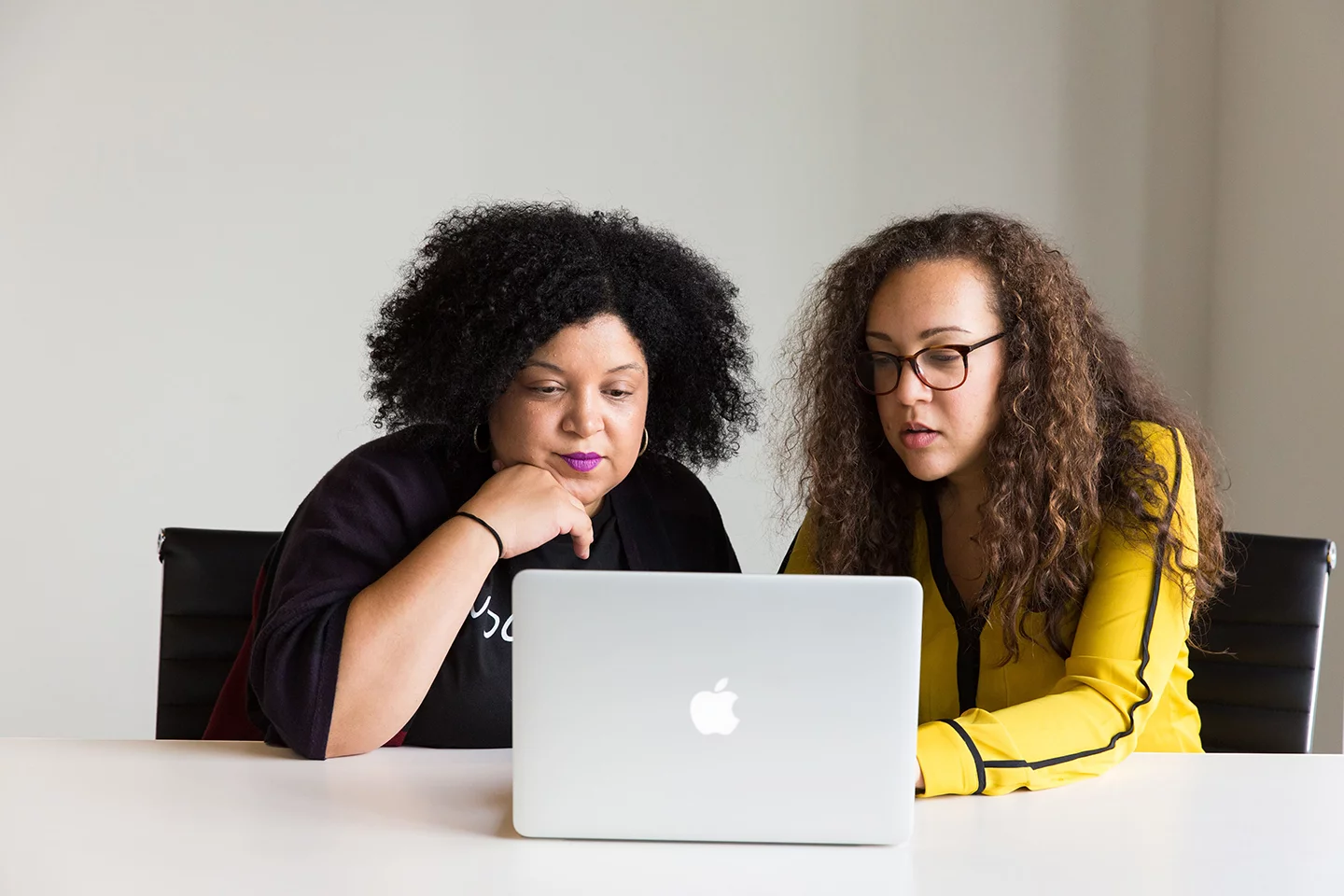You’ve built out diversity, equity, and inclusion training, but how do you allow your learners to practice those challenging conversations? Mursion’s own Nikki Eatchel, Chief Learning Officer, and Nicole Taylor, Director of Community, tackled this topic during our recent Future of Work roundtable session.
Below is an excerpt of Nikki’s presentation, which walks us through how Mursion thinks about and creates our simulations for DEI skills practice. To experience Mursion’s virtual reality simulations and see for yourself how this platform can support your own business to learn how VR can play a role in honing the interpersonal skills needed to foster a culture of coaching, schedule a demo today.
Nikki Eatchel: In just a few months, one of the first areas for focus for me has been diversity, equity, and inclusion. Huge, wonderful learning opportunity for me, and especially with the external subject-matter expert panel and panels that we’ve been able to work with. Really gleaned a lot of great lessons there, and wanting to walk through how that’s incorporated now into how we think about scenarios, and certainly how that’s shaping where we evolve to next.
With that, we have a typical cycle that we go through. In general, these are the major cycles. With the design process, it’s really about ensuring that we’re focused on the right content areas. That we’re looking at the right targeted skills because we are a practice solution. That we’re really grounding that in the right learning objectives and the right measurement so that we can provide really strong and valid information back to our learners and back to those learner organizations.
You can see in the expertise, as we look in that, is we certainly need the subject-matter expertise. That’s first and foremost in diversity, equity, and inclusion. As many of you know, who have already been through some of this work either with Mursion or elsewhere, as you’re creating that content, you don’t just create it and you’re done. There’s the creation component and thinking through that initial scenario concept, but then also the appropriate review, edit, approval. To make sure as you’re putting these scenarios together, which certainly are complex and nuanced, and, in this case, a more difficult area at times than some of the other areas we work in, to make sure we’re doing right by the organization and the learner. That takes review, edit, and iteration, as I’m sure you can all appreciate.
Once we’ve got some of that development and review under our belt, we look at overall bank creation. The way that Mursion works is we often work in a custom relationship with a client. They come with their own DEI expertise to the table and are looking for us to help create a custom scenario for them based on the expertise that they have and what they’d like to do within their organization.
The other kinds of clients we work with, however, don’t always have the luxury of having that DEI expertise in-house, or they might have the expertise in-house but don’t have the time or the resource to be able to apply to large-scale scenario development. That’s when we bring the DEI experts from our national panel together so that we can help create some of those scenarios and that baseline content to allow every organization to have that capability to drive DEI objectives within their organization. That’s where the bank creation comes from.
When we talk about scoring and reporting, that’s a general thing from a measurement perspective. It’s not the same thing here as it would be, for example, in an assessment environment because as we say often, this is not an assessment. This is not a pass/fail. You’re not getting a grade. This is a practice environment in order to be able to practice those difficult conversations and evolve as better and better human beings.
This is a practice environment in order to be able to practice those difficult conversations and evolve as better and better human beings.
When we talk about scoring and reporting, what we’re really talking about is, in essence, simulation feedback, and some of that data that can be collected, that can just be provided back to the learner so they can get a sense, objectively, of some of the things that they’re doing and how they’re performing within those sessions.
Then lastly, we think about the maintenance. That’s one piece, I will say in any area that I’ve worked in, that often gets neglected. That people focus on the initial development of certain components and solutions, but the ongoing maintenance doesn’t necessarily get the same level of attention. One of the things that’s been great in working with our external panels is also thinking through, how do we need to continue to evaluate simulations that are in use, not only from a data within the simulation itself, but in a learner response and what we’re seeing in growth pre- and post- those sessions.
Then also, do things shift over time. We’re not putting simulations out in a static environment. Social conditions change, businesses change, and sometimes a scenario that was maybe very well-placed and very valuable at one point in time isn’t necessarily as valuable a year later, and needs to be reconsidered and updated or, potentially, retired and replaced.
Creating Opportunities for Meaningful Practice
To jump in and apply those lessons learned in relationship to that cycle, it really comes down to three major points that I’m going to cover. One is around the content that you’re covering, one is around learner preparation, and the other one is around opportunity for practice.
As we think about lessons learned, this is probably not shocking to anybody on the call today. Particularly if you’re working within an organization in which you’re designing DEI curriculum or you’re providing DEI training or responsible for those activities within your organization, I’m sure you well-know that if you’re not focused in the right areas, then you’re spending time and effort that’s not really getting you the most value for your learners.
What we really wanted to work with our panel of experts with was ensuring that we were focused on the right objectives, the right content, the right skills. The first thing we did is really looked at objectives. Although, we’re not creating, by any means, training programs, we’re not driving the objectives within client organizations, we wanted to ensure that as we get down to training sessions, we can link them back to really what is driving goals within an organization.
The reason we say corporate DEI programs is because as you all know, far better than I do, DEI is not one position, it’s every position; and it’s not one market, it’s every market. We wanted to be very conscious that there’s different objectives and nuances in the education area, versus corporate, versus healthcare. While we’re working on those other areas as well, this first focus was certainly focused in that corporate environment.
DEI is not one position, it’s every position; and it’s not one market, it’s every market.
Once we got the objectives nailed down, the next question was, what are the content areas that should be covered within a program that’s focused on DEI? Because it’s really that content that then is going to link to those training opportunities or practice, opportunities.
First, general research in the area. Not just on the corporate side, but what was being covered from a content perspective in universities and in college courses and in certifications, as well as DEI-specific job descriptions, so we could be aware of that, as well. But in general, what was also being covered from a content perspective within organizations and within our client base. That was, again, reviewed by that phenomenal group of experts.
Building Better Diversity, Equity, Inclusion Training
For us, because we are not a DEI curriculum, we don’t create curriculum, we don’t do the training programs; for us, the skill level discussion is really important. Because in this scenario, and in those simulations, it’s really that skill practice that is most critical for us and where we get the biggest value out for the learner. For us, in addition to understanding that we could validly link back to content and objectives, we wanted to be able to ensure with our teams of experts that we were focused on the right skills as we were thinking about those.
There’s a number of different ways you can consider this, and if you go through research, you can go through a number of different models. Where we landed in relationship to strong research baseline was the connection between emotional intelligence skills and DE&I competencies. Same thing that you see is, I think, similarly in the leadership area as well. Because you can’t be a strong leader without being an inclusive leader, and those EQ skills certainly connect well there as well. We had some good discussions with the subject-matter experts we worked with to make sure that that connection made sense, and those skills not only were helpful to practice, but could link directly to those DE&I competencies.
The second question, though, that we had around that was, were they skills that could be improved with practice? There are some skills that certainly there’s debate around either you’re going to have that skill or you’re not, inherently, and which skills could you actually get better at with practice over time.
That certainly rolls into social accountability as well. That gets to be a little bit more difficult than a singular scenario, but those levels, I think, were really critical for us to consider and to flesh out with that team. Because ensuring that you’ve got the right content is only so helpful if you’re not focused on all the appropriate levels that need to be practicing those skills.
That was super helpful with us in regards to lessons learned because again, we want to make sure that every opportunity we have to help a learner is well-focused and there’s strong value that comes out of that. So, that was an incredibly helpful set of activities with that group of experts.
Meeting Learners Where They Are
This is an interesting space for us at Mursion because we’re not the responsible party for preparing the vast majority of the learners or providing them the information they need prior to the session. That’s coming through the organization that we’re working with.
If you think about it in the bell curve, the far end of the spectrum, where somebody has been through great curriculum and great training, and they’re highly engaged, and they’ve had lots of communication about what this practice session is going to be, and they come in excited and open and they get a ton out of it.
We also have the other far end of the spectrum, where maybe it’s an organization where any kind of curriculum is voluntary, so maybe this person didn’t choose to do any. Maybe there wasn’t a lot of follow-up within the organization, or there was and they just weren’t engaged. Potentially, there wasn’t maybe a lot of discussion about what these practice sessions would be like.
It is a key area to be focused on. One of the things that was helpful for us in these discussions was to think through the additional types of conversation and assistance we could potentially think about providing to help ensure our clients came really well-prepared, their candidates or their learners.
From our perspective, we do provide as much support as we can in relationship to the sessions that learners are going to participate in. That can include product information. What do you expect to do in this flow? How is that going to work when you’re in a session? Working through the avatar component. People don’t talk to avatars every day, so sort of warning people about what that’s going to be like, and talking through that there is a human behind the scene. All of that is helpful in getting somebody in the right mindset as they walk into it.
Certainly, providing scenario information. What are they going to talk about? What is the issue that they’re going to be talking about? What is the objective? What are they trying to accomplish within that scenario? What are the strategies that they can apply to accomplish those goals? Having that information, certainly, again, very helpful for the learner.
I think, equitably as important, particularly in the area of DEI, is talking through with the learner, what to expect in the session from an emotional standpoint and what is considered a good session. We’ve got potential emotions that can come up. These are difficult conversations. Letting people know ahead of time, “Look, these are difficult conversations. It’s okay to be uncomfortable. It’s okay to feel it’s maybe not going as well as you want it to. It’s private. It’s safe.” Just letting them know that that’s likely to come up is also very helpful, so a learner isn’t surprised, or doesn’t feel more nervous than they need to that they’re going to be heading into what can be uncomfortable conversations.
I think part of that is also framing success. Reminding people this isn’t a test. It’s not a pass/fail. You’re not going to get a grade. The whole point of it is to have a safe and brave space to be able to try different things and handle conversations that a lot of people in real-life either get defensive in or avoid.
Our last lesson, the third piece we talked about with our groups pretty extensively at various points was the need to create muscle memory. We think about practice a lot, and we think about that in relationship to a lot of other things, but we don’t tend to think about it in relationship to conversations. If you’re practicing a sport or if you’re learning a new language, all of that practice is critically important.
We think about practice a lot, and we think about that in relationship to a lot of other things, but we don’t tend to think about it in relationship to conversations.
Then as we think about the deliberate practice and what that curve of improvement is, is the more you practice, the better you get at something. But I think more importantly from our perspective, this curve is missing, when you’re talking about something like a DEI conversation, that even initial hurdle before you get to the curve of getting through that fight-or-flight instinct. When people are presented with an uncomfortable conversation, often, as I’m sure you all know as well as I do or better, that there’s either a potential defensiveness that comes into play immediately or an avoidance.
Starbucks was referenced earlier. I think they’ve been really great at ensuring that their learners get multiple sessions. Even though one or two sessions can certainly be helpful, and we hear that from learners as well because it gives them that opportunity to think about those things, long-term behavioral change, as we all know, it’s just, learning a language. If you stopped speaking it, eventually you’re going to lose it. That ongoing practice is critical to transformational and long-term change.
That ongoing practice is critical to transformational and long-term change.
The last thing I’ll say is it’s not just the repetitive practice. It’s making sure that practice is followed by important components. One of them is that reflection piece. Learning theory will tell you that reflection component is really important.
Being able to think through, how did I feel during that conversation? Where were the points of the conversation I felt really good? Where were the points of the conversation I felt really stressed out, or felt I could have done better, or felt defensive and why? Thinking through those and the strategies and having a chance to think through what you could do better later is a critical component of that, and/or celebrating what you did really well that you didn’t know you did really well. Those things are critically important.
I think where we also want to make sure we’re helping learners is giving them information on, did they accomplish their objectives? How did the other person in the room feel in that meeting? Then we’re also building towards providing data that tells somebody, “I might think I’m really great at balanced conversation,” and then I get data back from a session that goes, no, you talked 90% of the time. That might be something I’m blind to, unless I see more of that objective information.
I, certainly, at the end of my days, will think back and go, “Oh, today I did a really good job supporting that person.” The next day I might go, “Oh, man, I really blew that conversation.” Being able to go back and look and see what your patterns look like, and where you weren’t feeling good and what happened during those times, I think is incredibly helpful in the learning and behavioral change.
Subscribe for the latest Mursion articles and updates.
By clicking the sign up button above, you consent to allow Mursion to store and process the personal information submitted above to provide you the content requested. View our Terms and Conditions.




